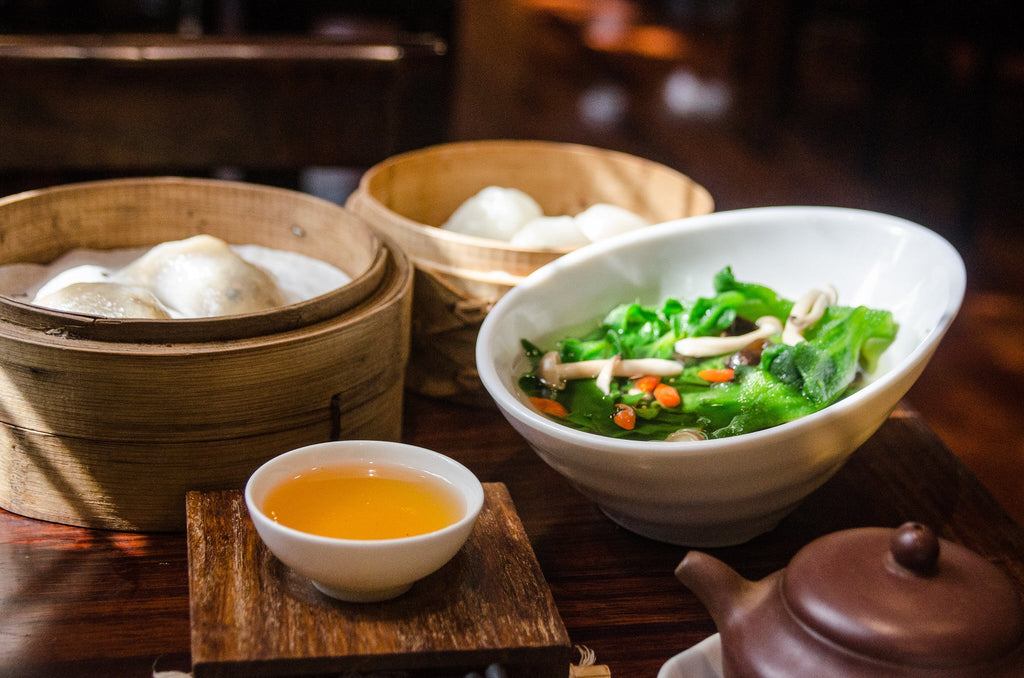The Taste Index: How to Pick a Tea Based on the Flavors You Love

If you're just beginning to learn about tea, it can be tough to know where to begin. Even within clear categories like green tea or oolong, individual teas can taste wildly different from one another. While certain regions tend to produce teas of a specific character—80% of tea grown in Japan is green tea processed more or less the same way—there are exceptions everywhere. What's a budding tea drinker to do?
Perhaps the best place to begin is with your own personal tastes. At the tea table, we often ask new drinkers what other beverage flavors they tend to enjoy, such as crisp, minerally white wine or nutty dark roast coffee. Then we find teas that hit similar notes. (This also gets really fun in organized pairings, like tea & chocolate or tea & cheese tastings.)
Here is a guide to help you figure out your own tea tastes, with our recommendations for the styles we think you'll love.
Grassy and vegetal
If you savor fresh flavors like spring peas and baby spinach, green teas may be for you. But not all greens taste the same. The two most significant regions of green tea production are China and Japan. Chinese teas tend to be pan-fired or oven dried to halt oxidation, emphasizing subtle aromas and a delicate toasted flavor; Japanese teas are instead steamed, which coaxes out deep marine accents.
- Jade Spring: A classic Chinese green profile, balancing a fresh vegetal character with notes of chestnut and sweet corn.
- Sencha Fukamushi: Sencha is the archetypal Japanese green tea. This deep-steamed version from Shizuoka has a denser verdant character than the Chinese green tea above; think cut grass and umami-rich seaweed.
Floral and fragrant
Many teas are processed in ways that specifically highlight their aroma, often with a distinctive floral character; less grandma's perfume and more field of wildflowers in July. These teas tend toward a light to moderate body, with creamy sugar cookie undertones.
- Jasmine Pearls: A green tea traditionally scented with fresh jasmine blossoms before being hand rolled into individual pearls, the floral fragrance is prominent. Quality jasmine pearls are judged by the depth and clarity of that aroma, with no off-notes from chemical additives.
- Nantou Four Seasons: Lightly oxidized teas grown at high elevations are a staple of Taiwanese tea cultivation. The exact flavor and fragrance of these fragrant oolongs vary by mountain region and production style, but most yield creamy, greeny, slightly piney flavors in the cup.
Citrus and sunshine
There's nothing like that spray of citrus oil on your fingers when you tear apart the first clementine of winter. If the heady breeze of fresh lime—or pleasingly bittersweet orange marmalade—calls your name, dip into these bright teas.
- Earl Grey: One of the most beloved flavored teas, our Earl Grey is made from brisk Indian black tea flavored with bergamot citrus oil. The best Earl Grey uses only bergamot, with no synthetic enhancements.
- Green Tangerine Pu-erh: In China and elsewhere, citrus skins are used in traditional medicine, and often paired with ripened pu-erh tea, blending the fresh aroma with mellow, earthy leaf.
- Phoenix Honey Orchid: Phoenix oolongs from China's Guangdong Province are renowned for their tantalizing fragrance; this "honey orchid" cultivar boasts a bold citrus character with woody undertones that will appeal to incense lovers.
Ripe and fruity
If you seek out the cherry notes of a Pinot Noir or are first in line at the farmers market for summer peaches, you may prefer teas that are moderately to heavily oxidized, such as oolong and black teas, and with less astringency, which allows their fruity character to shine through.
- Darjeeling 2nd Flush: The late spring to early summer harvest of Darjeeling teas is called the second flush, which is more heavily oxidized than the first. Our selection of single-estate Darjeelings changes every year, as each one has its own fruity, wine-like charms.
- Oriental Beauty, Late Summer Harvest: A Taiwanese oolong processed a lot like an Indian black tea, Oriental Beauty—also known as dong feng mei ren or bai hao—has a unique honeyed character and juicy body, like biting into a ripe plum. It's also highly fragrant, and lasts for many steeps.
- Spring Fortune: If your eyes light up for tropical fruits, try this unique handmade gem from Taiwan, which is full of pineapple aromas encircling nectar-like body.
Woody and arboreal
Some teas capture the feeling of a walk in the woods or opening an old cedar chest. These tend to be heavily oxidized, made from larger leaves, and hit further back in your palate. Their sweetness, while present, is more subtle than the teas mentioned above.
- Wood Dragon: Tea stems and twigs have a character all their own, that—surprise surprise—is full of woody flavor. This is a roasted tea made from high quality high mountain oolong tea stems. Its body is light and refreshing, belying a deeper caramelized taste.
- Lu'an Heicha: A unique fermented tea, aged in bamboo baskets. The particular leaf material and processing method yield a brew with deep tobacco notes and a hint of sandalwood.
Chocolate and nuts
Rich and roasted, soft and comforting, bedfellows chocolate and nuts merits a flavor category all their own. There's a lot of crossover between the oxidation and roasting process of cacao and Camellia sinensis, most notably in heavily oxidized black teas from the Himalayas and parts of China.
- Himalayan Black: Add some milk to this unique Nepali production and you'd swear you're drinking chocolate milk. On its own, the tea's melted-chocolate notes are joined by accents of brown sugar and black cherry.
- Darjeeling 2nd Flush: The fruity and nutty character of some second-flush Darjeelings can conspire to make something a lot like warm cacao, especially when you keep in mind the cacao pod is a fruit.
Savory and strong
Good tea isn't just about sweets and scones. While it can't match the salty punch of a kosher dill pickle or a dry sherry, some teas exhibit a distinct savory quality. This can be the result of processing or the leaf itself; l-theanine, an amino acid with calming properties, also contributes a richness to some teas.
- Sencha Kabuse: Made from early spring harvests in which the leaves are shaded before plucking, this Japanese green tea has a distinct vegetal aroma and deep salinity, like sipping some dashi broth.
- Tung Ting: The subtle twang and moderate roast of this oolong style from Taiwan can result in a clear savory character; think toasted sesame seeds. The apricot aroma of this particular lot makes it a great eye-opener.
- Sheng Cupcake Pu-erh: Traditionally processed sheng pu-erh tea often picks up some smokiness during processing. Combine that with the astringent bite of a middle-aged fermented tea and you have a bold brew with almost meaty, mouthwatering intensity.
Smoke and charcoal
Fans of smoked cheeses and live-fire cooking have a lot to discover in tea. Smoky flavors can be added to tea during drying or in a subsequent roasting step. When done right, this processing enhance the inherent flavors of the leaf without obliterating them.
- Lapsang Souchong: Also called Russian Caravan, this famous Chinese black tea sees some smoke during processing, which yields a rich and heady cup. Traditionally, as in our Tongmu Reserve version of this tea, the touch of smoke was subtle, but foreign drinkers responded so well to heavily smoked versions that it's become a style all its own.
- High Mountain Ali Shan Traditional Style: Multiple sessions of careful roasting by a renown expert transform this oolong into a smooth, smoldering wonder. As you steep and resteep, the balanced charcoal aroma gradually gives way to nuances underneath.
- Tieluohan: Oolong teas from the Wuyi Cliffs of China are renowned for their deep roast—which occurs many times over several months—and strong mineral flavor. Scotch whisky drinkers, this is the tea for you.
Earthy and fermented
If you love caramelized mushrooms and getting your hands dirty in the garden, look for heavily oxidized and fermented teas. You'll probably enjoy shu pu-erh, a tea that's pile-fermented to develop a rich and earthy character, brews thick like molasses, and is easy on the stomach. There's a reason it's so often served with dim sum as a digestive aid.
- Shu Truffle Pu-erh: These single-serving nuggets of ripened pu-erh tea have a beautiful note of petrichor, with a touch of eucalyptus in the finish. Simply drop one into your mug, and re-steep the leaves all day.
- Mao Feng Black: A Chinese black tea with a darker character than most; this particular lot has balanced elements of ginseng and roasted sweet potato.
- Horse Shu Pu-erh: Ripened pu-erh tea stuffed, roasted, and aged inside bamboo. The extra processing adds subtle sugarcane sweetness to the tea, and in this case, aromas of clay and earth.
